Small overlap front
The small overlap front evaluation consists of a driver-side and a passenger-side component. If the results of the two evaluations differ, then the combined small overlap rating is equal to the lower rating.
Driver-side
- Rating applies to 2021-25 models
Tested vehicle: 2021 Kia K5 LXS 4-door
The Kia K5 was introduced in the 2021 model year, replacing the Optima nameplate in the Kia lineup. Driver-side small overlap frontal ratings are assigned by the Institute based on a test of a 2021 K5 conducted by Hyundai/Kia.
| Evaluation criteria | Rating |
|---|---|
| Overall driver-side evaluation | |
| Structure and safety cage | |
| Driver injury measures | |
| Head/neck | |
| Chest | |
| Hip/thigh | |
| Lower leg/foot | |
| Driver restraints and dummy kinematics | |
Passenger-side
- Rating applies to 2021-25 models
Tested vehicle: 2021 Kia K5 LXS 4-door
The Kia K5 was introduced in the 2021 model year, replacing the Optima nameplate in the Kia lineup. Passenger-side small overlap frontal ratings are assigned by the Institute based on a test of a 2021 K5 conducted by Hyundai/Kia.
| Evaluation criteria | Rating |
|---|---|
| Overall passenger-side evaluation | |
| Structure and safety cage | |
| Passenger injury measures | |
| Head/neck | |
| Chest | |
| Hip/thigh | |
| Lower leg/foot | |
| Passenger restraints and dummy kinematics | |
| Driver injury measures | |
| Head/neck | |
| Chest | |
| Hip/thigh | |
| Lower leg/foot | |
| Driver restraints and dummy kinematics | |
Moderate overlap front: original test
Rating applies to 2021-25 models
Tested vehicle: 2021 Kia K5 LXS 4-door
The Kia K5 was introduced in the 2021 model year, replacing the Optima nameplate in the Kia lineup. Moderate overlap frontal ratings are assigned by the Institute based on a test of a 2021 K5 conducted by Hyundai/Kia.
| Evaluation criteria | Rating |
|---|---|
| Overall evaluation | |
| Structure and safety cage | |
| Driver injury measures | |
| Head/neck | |
| Chest | |
| Leg/foot, left | |
| Leg/foot, right | |
| Driver restraints and dummy kinematics | |
Moderate overlap front: updated test
Rating applies to 2023-25 models
Tested vehicle: 2023 Kia K5 LXS 4-door
The Kia K5 was introduced in the 2021 model year, replacing the Optima nameplate in the Kia lineup.
| Evaluation criteria | Rating |
|---|---|
| Overall evaluation | |
| Structure and safety cage | |
| Driver injury measures | |
| Head/neck | |
| Chest | |
| Thigh/hip | |
| Leg/foot | |
| Driver restraints and dummy kinematics | |
| Rear passenger injury measures | |
| Head/neck | |
| Chest | |
| Thigh | |
|
Rear passenger restraints and dummy kinematics
| |

View of the vehicle after the crash showing the airbags and damage to the occupant compartment.
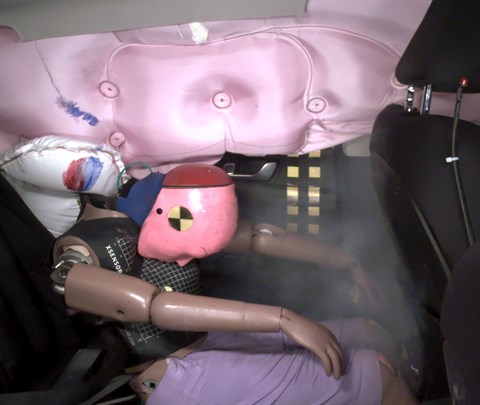
The rear passenger dummy's head remained a safe distance from the front seatback.
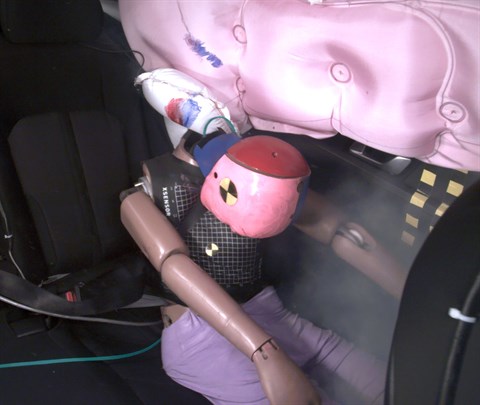
Rear passenger dummy injury values indicate a likely risk of injury to the head or neck and chest. During the crash, the shoulder belt remained in an ideal position on the dummy’s chest.
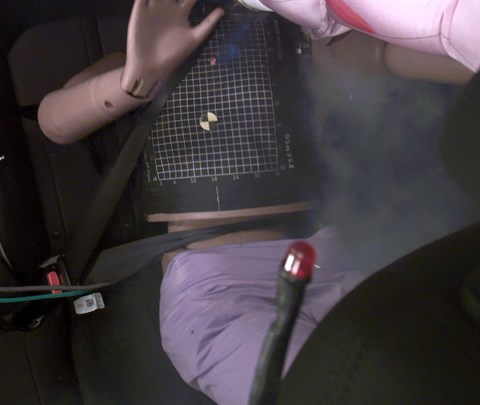
The rear passenger dummy's lap belt moved from the ideal position on the pelvis onto the abdomen, increasing the risk of abdominal injuries.
Side: original test
Rating applies to 2021-25 models
Tested vehicle: 2021 Kia K5 LXS 4-door
The Kia K5 was introduced in the 2021 model year, replacing the Optima nameplate in the Kia lineup. Side ratings are assigned by the Institute based on a test of a 2021 Kia K5 conducted by Hyundai/Kia.
| Evaluation criteria | Rating |
|---|---|
| Overall evaluation | |
| Structure and safety cage | |
| Driver injury measures | |
| Head/neck | |
| Torso | |
| Pelvis/leg | |
| Driver head protection | |
| Rear passenger injury measures | |
| Head/neck | |
| Torso | |
| Pelvis/leg | |
| Rear passenger head protection | |
Side: updated test
Rating applies to 2021-25 models
Tested vehicle: 2023 Kia K5 LXS 4-door
The Kia K5 was introduced in the 2021 model year, replacing the Optima nameplate in the Kia lineup.
| Evaluation criteria | Rating |
|---|---|
| Overall evaluation | |
| Structure and safety cage | |
| Driver injury measures | |
| Head/neck | |
| Torso | |
| Pelvis | |
|
Driver head protection
The dummy's head moved downward past the side curtain airbag and struck the window sill of the driver door. The head protection is inadequate. | |
| Rear passenger injury measures | |
| Head/neck | |
| Torso | |
| Pelvis | |
| Rear passenger head protection | |
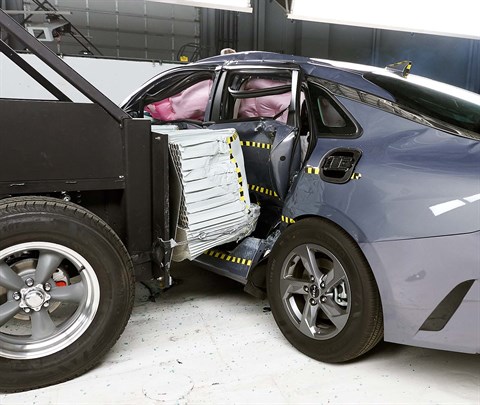
View of the vehicle just after the crash test.
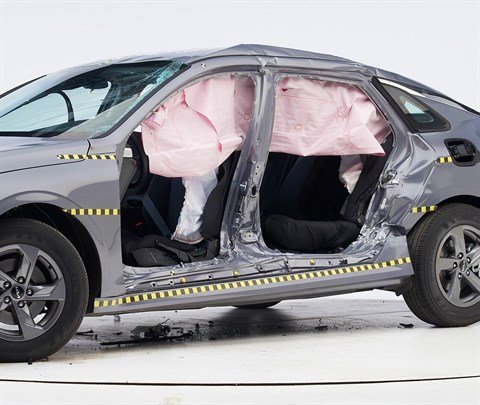
View of the vehicle after the crash with doors removed, showing the side airbags and damage to the occupant compartment.
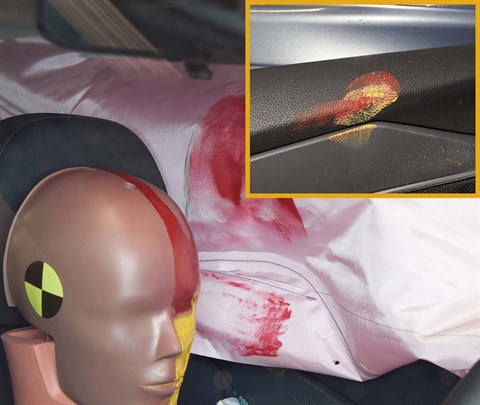
Smeared greasepaint shows that the driver dummy's head moved downward, past the side curtain airbag, and contacted the window sill.
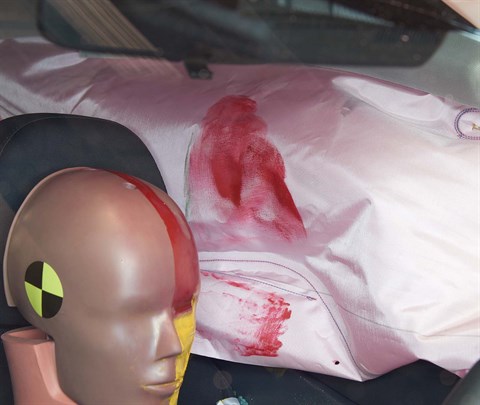
Smeared greasepaint shows where the rear passenger dummy’s head was protected by the side airbag.
Seat belt reminders
Rating applies to 2023-25 models
| Evaluation criteria | Rating |
|---|---|
| Overall evaluation | |
| Front row | |
| Unbelted occupant alert (audible & visual) | |
| Initiation time | |
| Duration | Long enough (90+ seconds) |
| Volume | |
| Audio frequency | |
| Second row | |
| Startup status alert (visual) | None |
Child seat anchors
Rating applies to 2021-25 models
| Evaluation criteria | Rating |
|---|---|
| Overall evaluation | |
| Vehicle trim | LXS |
| Seat type | cloth |
This vehicle has 2 rear seating positions with complete child seat attachment (LATCH) hardware.
It has 1 additional seating position with a tether anchor only.
| Evaluation criteria | Rating |
|---|---|
| Overall evaluation | |
| Vehicle trim | LXS |
| Seat type | cloth |
| Rating icon | Rating |
|---|---|
| G | Good |
| A | Acceptable |
| M | Marginal |
| P | Poor |
| Seating positions that rely on borrowed lower anchors or have only a tether anchor available are not rated. | |
thether anchor symbol | Tether anchor |
lower anchor symbol | Lower anchors |
| Lower anchor(s) can be borrowed from adjacent positions(s) | |
| No hardware available |
Details by seating position
| Position | Rating |
|---|---|
| 1 | |
| Tether anchor | |
| easy-to-find location | |
| no other hardware could be confused for anchor | |
| Lower anchors | |
| too deep in seat | |
| not too much force needed to attach | |
| easy to maneuver around anchors | |
| 2 | |
| Tether anchor | |
| easy-to-find location | |
| no other hardware could be confused for anchor | |
| Lower anchors | |
| none available | |
| 3 | |
| Tether anchor | |
| easy-to-find location | |
| no other hardware could be confused for anchor | |
| Lower anchors | |
| too deep in seat | |
| not too much force needed to attach | |
| easy to maneuver around anchors |
